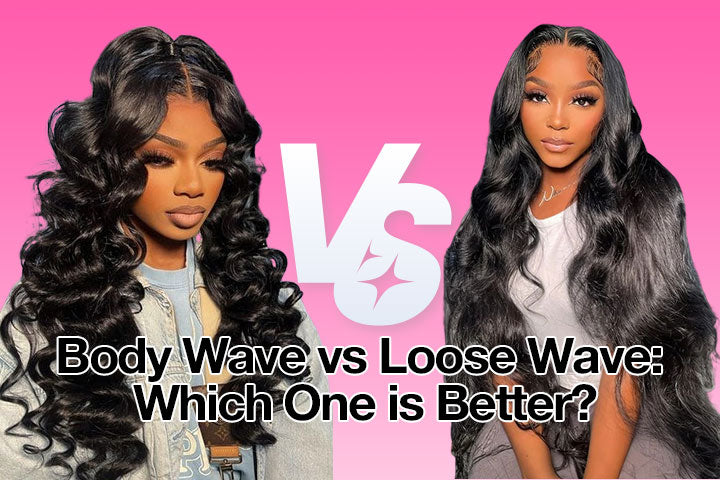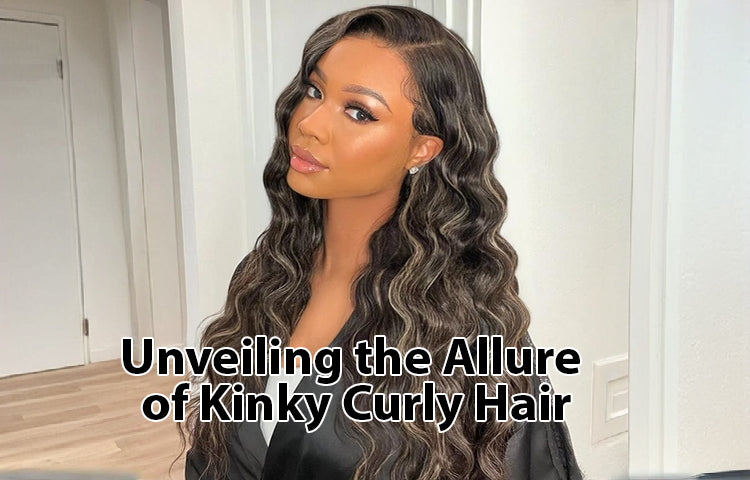Wig vs Weave: What is The Difference and How to Choose
When it comes to transforming hairstyle, wigs and hair weaves are two popular options that offer versatility and the opportunity to switch up your look. However, understanding the differences between these hair extensions is crucial to making the right choice for your unique needs.
In this blog post, we'll dive into what exactly hair weaves and wigs are, highlight the key distinctions between them, and provide tips on how to choose between the two.
A wig refers to a hairpiece, either made from synthetic or human hair, that is sewn onto a wig cap. The core of a wig is the cap base inside. In simpler terms, wearing a wig is akin to wearing a hat with hair sewn into it. Wigs come in various types, such as lace wigs, glueless wigs, v-part wigs, u-part wigs, and more.
Among the various types of wigs available today, lace wigs are the most popular and commonly seen. The lace portion of these wigs mimics the appearance of a human scalp, with hair individually hand-placed on the lace base, creating the illusion that the hair is growing directly from the scalp.
There are several subtypes of lace wigs, including wear go glueless wigs, closure wigs (featuring lace only in the crown area), lace front wigs (with lace extending from ear to ear), 360 lace wigs (with lace around the perimeter of the wig), and full lace wigs (featuring a cap made entirely of lace). Except wear go glueless wigs, installing such lace wigs typically requires the use of adhesive to secure them in place.

Features of Human Hair Wigs
Pros:
Full Coverage: Wigs cover the entire scalp, providing a complete change in hairstyle and concealing hair loss or baldness.
Quick Styling: Wigs offer a fast and easy way to change your look without the long-term commitment of a hairstyle change.
Variety of Styles: Human hair wigs come in a wide range of styles, colors, lengths, and textures, providing versatility in looks and customization.
Natural Appearance: High-quality human hair wigs can be styled to look natural and have a realistic appearance. Lace front wigs, in particular, have a natural hairline.
Protection: Wigs can protect your natural hair from environmental damage, heat styling, and chemical treatments, allowing it to grow and stay healthy.
Cons:
Maintenance: Human hair wigs require regular care, including washing, conditioning, and styling, to maintain their appearance and quality.
Cost: Human hair wigs are generally more expensive than synthetic wigs due to the authenticity and versatility of the hair.
Comfort and Breathability: Some people find wigs less breathable and comfortable to wear for extended periods, especially in hot or humid conditions.

What is a Hair Weave
A hair weave is a hair extension technique where natural or synthetic hair is sewn into your own hair or onto a braided base to add length, volume, or texture. The process involves creating small, tight braids close to your scalp, onto which wefts of hair are then sewn or bonded. Hair weaves come in various styles, including sew-in, glued-in, and clip-in options.

Features of Hair Weaves
Pros:
Natural Blend: Hair weaves can be seamlessly integrated with your natural hair, providing a natural and cohesive look.
Versatility: Weaves allow for various styling options, including straight, curly, or textured looks, while maintaining your natural hair.
Partial Enhancement: They are suitable for adding length, volume, or texture without replacing your natural hair entirely.
Longevity: Hair weaves can be worn for an extended period (6-8 weeks) before needing adjustment or removal.
Protection: Weaves can protect your natural hair by allowing it to rest from daily styling and manipulation.
Cons:
Installation Time: The initial installation of hair weaves can be time-consuming, and the process may take several hours.
Cost: The cost of hair weaves can vary, with high-quality extensions and professional installation sometimes being quite expensive.
Potential Damage: Poorly installed hair weaves can lead to damage to your natural hair, including breakage or hair loss if not done correctly.
Comfort and Sensation: Some people may find weaves uncomfortable or itchy during the adjustment period, and they may take time to get used to.
What is the Differences Between Weave and Wigs
Install Method
Weaves are attached by sewing or bonding extensions to your natural hair or braided base. Wigs are worn over your natural hair and are secured with clips, combs, adjustable straps inside the wig cap, or adhesive(lace wigs).
Duration of Wear
Hair weaves can last for 6-8 weeks, whereas the longevity of wigs, especially lace frontal wigs secured with adhesive, is typically around 2-6 weeks. Lifespan
Generally, hair weaves can be reused up to three times. Human hair wigs have a lifespan of 1-3 years, while synthetic wigs typically last for 4-6 months.
Maintenance
Weaves require regular care to maintain the integrity of your natural hair and extensions.Wigs are easier to maintain and require less upkeep for your natural hair.

How to choose
Lifestyle
Take a close look at your daily routine and the time you can allocate to hair maintenance. If your life is fast-paced and you favor low-maintenance solutions, wigs may align better with your lifestyle.
Desired Hairstyle Changes
If you relish the art of reinventing your look frequently, wigs emerge as the top choice. Their versatility allows you to effortlessly switch between different hairstyles and appearances.
For women, especially those dealing with hair thinning or baldness, wigs are a superior choice. Weaves can exert more pressure on your scalp and existing hair, making wigs a gentler alternative.
Conclusion
In the wig vs weave debate, the choice ultimately depends on your preferences, lifestyle, and hair health. Both options offer their unique advantages, so consider what works best for you. Whether you opt for the convenience of a wig or the longevity of a weave, hair extensions can be a fantastic way to express your style and enhance your natural beauty.














